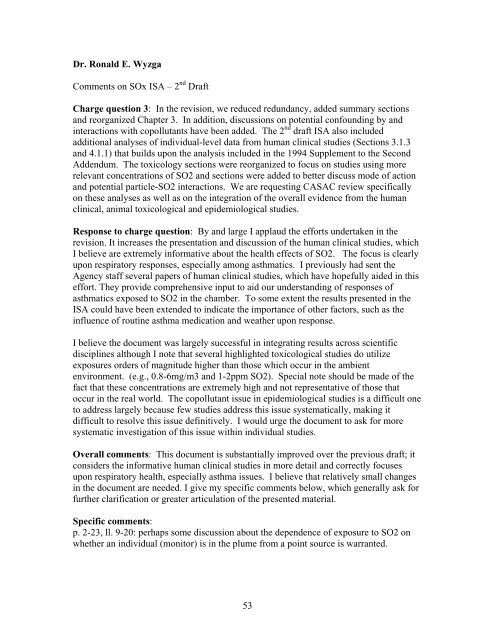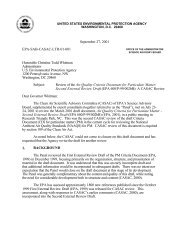(CASAC) Peer Review of EPA's Integrated Science Assessment
(CASAC) Peer Review of EPA's Integrated Science Assessment
(CASAC) Peer Review of EPA's Integrated Science Assessment
You also want an ePaper? Increase the reach of your titles
YUMPU automatically turns print PDFs into web optimized ePapers that Google loves.
Dr. Ronald E. WyzgaComments on SOx ISA – 2 nd DraftCharge question 3: In the revision, we reduced redundancy, added summary sectionsand reorganized Chapter 3. In addition, discussions on potential confounding by andinteractions with copollutants have been added. The 2 nd draft ISA also includedadditional analyses <strong>of</strong> individual-level data from human clinical studies (Sections 3.1.3and 4.1.1) that builds upon the analysis included in the 1994 Supplement to the SecondAddendum. The toxicology sections were reorganized to focus on studies using morerelevant concentrations <strong>of</strong> SO2 and sections were added to better discuss mode <strong>of</strong> actionand potential particle-SO2 interactions. We are requesting <strong>CASAC</strong> review specificallyon these analyses as well as on the integration <strong>of</strong> the overall evidence from the humanclinical, animal toxicological and epidemiological studies.Response to charge question: By and large I applaud the efforts undertaken in therevision. It increases the presentation and discussion <strong>of</strong> the human clinical studies, whichI believe are extremely informative about the health effects <strong>of</strong> SO2. The focus is clearlyupon respiratory responses, especially among asthmatics. I previously had sent theAgency staff several papers <strong>of</strong> human clinical studies, which have hopefully aided in thiseffort. They provide comprehensive input to aid our understanding <strong>of</strong> responses <strong>of</strong>asthmatics exposed to SO2 in the chamber. To some extent the results presented in theISA could have been extended to indicate the importance <strong>of</strong> other factors, such as theinfluence <strong>of</strong> routine asthma medication and weather upon response.I believe the document was largely successful in integrating results across scientificdisciplines although I note that several highlighted toxicological studies do utilizeexposures orders <strong>of</strong> magnitude higher than those which occur in the ambientenvironment. (e.g., 0.8-6mg/m3 and 1-2ppm SO2). Special note should be made <strong>of</strong> thefact that these concentrations are extremely high and not representative <strong>of</strong> those thatoccur in the real world. The copollutant issue in epidemiological studies is a difficult oneto address largely because few studies address this issue systematically, making itdifficult to resolve this issue definitively. I would urge the document to ask for moresystematic investigation <strong>of</strong> this issue within individual studies.Overall comments: This document is substantially improved over the previous draft; itconsiders the informative human clinical studies in more detail and correctly focusesupon respiratory health, especially asthma issues. I believe that relatively small changesin the document are needed. I give my specific comments below, which generally ask forfurther clarification or greater articulation <strong>of</strong> the presented material.Specific comments:p. 2-23, ll. 9-20: perhaps some discussion about the dependence <strong>of</strong> exposure to SO2 onwhether an individual (monitor) is in the plume from a point source is warranted.53
















